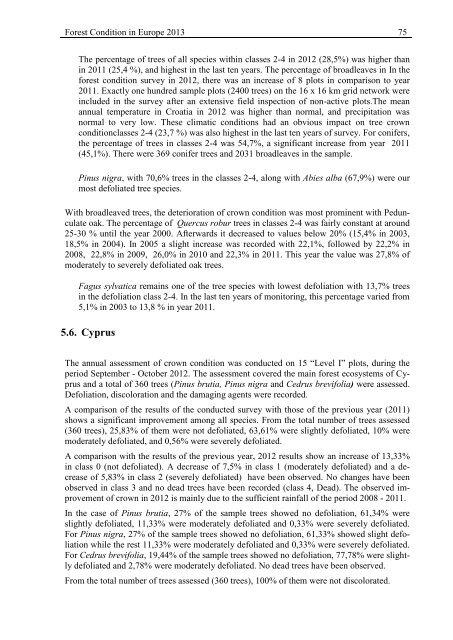Forest Condition in Europe - ICP Forests
Forest Condition in Europe - ICP Forests
Forest Condition in Europe - ICP Forests
You also want an ePaper? Increase the reach of your titles
YUMPU automatically turns print PDFs into web optimized ePapers that Google loves.
<strong>Forest</strong> <strong>Condition</strong> <strong>in</strong> <strong>Europe</strong> 2013 75<br />
The percentage of trees of all species with<strong>in</strong> classes 2-4 <strong>in</strong> 2012 (28,5%) was higher than<br />
<strong>in</strong> 2011 (25,4 %), and highest <strong>in</strong> the last ten years. The percentage of broadleaves <strong>in</strong> In the<br />
forest condition survey <strong>in</strong> 2012, there was an <strong>in</strong>crease of 8 plots <strong>in</strong> comparison to year<br />
2011. Exactly one hundred sample plots (2400 trees) on the 16 x 16 km grid network were<br />
<strong>in</strong>cluded <strong>in</strong> the survey after an extensive field <strong>in</strong>spection of non-active plots.The mean<br />
annual temperature <strong>in</strong> Croatia <strong>in</strong> 2012 was higher than normal, and precipitation was<br />
normal to very low. These climatic conditions had an obvious impact on tree crown<br />
conditionclasses 2-4 (23,7 %) was also highest <strong>in</strong> the last ten years of survey. For conifers,<br />
the percentage of trees <strong>in</strong> classes 2-4 was 54,7%, a significant <strong>in</strong>crease from year 2011<br />
(45,1%). There were 369 conifer trees and 2031 broadleaves <strong>in</strong> the sample.<br />
P<strong>in</strong>us nigra, with 70,6% trees <strong>in</strong> the classes 2-4, along with Abies alba (67,9%) were our<br />
most defoliated tree species.<br />
With broadleaved trees, the deterioration of crown condition was most prom<strong>in</strong>ent with Pedunculate<br />
oak. The percentage of Quercus robur trees <strong>in</strong> classes 2-4 was fairly constant at around<br />
25-30 % until the year 2000. Afterwards it decreased to values below 20% (15,4% <strong>in</strong> 2003,<br />
18,5% <strong>in</strong> 2004). In 2005 a slight <strong>in</strong>crease was recorded with 22,1%, followed by 22,2% <strong>in</strong><br />
2008, 22,8% <strong>in</strong> 2009, 26,0% <strong>in</strong> 2010 and 22,3% <strong>in</strong> 2011. This year the value was 27,8% of<br />
moderately to severely defoliated oak trees.<br />
Fagus sylvatica rema<strong>in</strong>s one of the tree species with lowest defoliation with 13,7% trees<br />
<strong>in</strong> the defoliation class 2-4. In the last ten years of monitor<strong>in</strong>g, this percentage varied from<br />
5,1% <strong>in</strong> 2003 to 13,8 % <strong>in</strong> year 2011.<br />
5.6. Cyprus<br />
The annual assessment of crown condition was conducted on 15 “Level I” plots, dur<strong>in</strong>g the<br />
period September - October 2012. The assessment covered the ma<strong>in</strong> forest ecosystems of Cyprus<br />
and a total of 360 trees (P<strong>in</strong>us brutia, P<strong>in</strong>us nigra and Cedrus brevifolia) were assessed.<br />
Defoliation, discoloration and the damag<strong>in</strong>g agents were recorded.<br />
A comparison of the results of the conducted survey with those of the previous year (2011)<br />
shows a significant improvement among all species. From the total number of trees assessed<br />
(360 trees), 25,83% of them were not defoliated, 63,61% were slightly defoliated, 10% were<br />
moderately defoliated, and 0,56% were severely defoliated.<br />
A comparison with the results of the previous year, 2012 results show an <strong>in</strong>crease of 13,33%<br />
<strong>in</strong> class 0 (not defoliated). A decrease of 7,5% <strong>in</strong> class 1 (moderately defoliated) and a decrease<br />
of 5,83% <strong>in</strong> class 2 (severely defoliated) have been observed. No changes have been<br />
observed <strong>in</strong> class 3 and no dead trees have been recorded (class 4, Dead). The observed improvement<br />
of crown <strong>in</strong> 2012 is ma<strong>in</strong>ly due to the sufficient ra<strong>in</strong>fall of the period 2008 - 2011.<br />
In the case of P<strong>in</strong>us brutia, 27% of the sample trees showed no defoliation, 61,34% were<br />
slightly defoliated, 11,33% were moderately defoliated and 0,33% were severely defoliated.<br />
For P<strong>in</strong>us nigra, 27% of the sample trees showed no defoliation, 61,33% showed slight defoliation<br />
while the rest 11,33% were moderately defoliated and 0,33% were severely defoliated.<br />
For Cedrus brevifolia, 19,44% of the sample trees showed no defoliation, 77,78% were slightly<br />
defoliated and 2,78% were moderately defoliated. No dead trees have been observed.<br />
From the total number of trees assessed (360 trees), 100% of them were not discolorated.
















